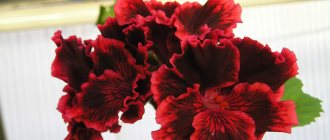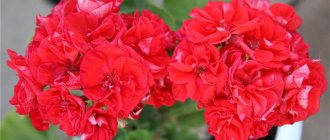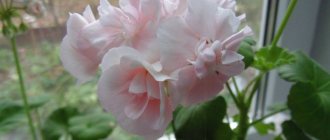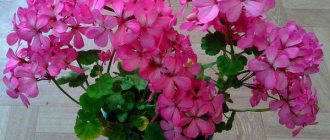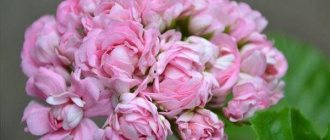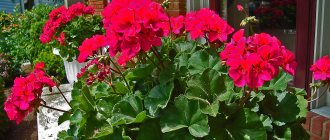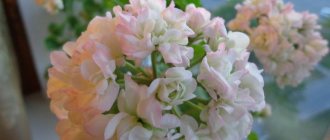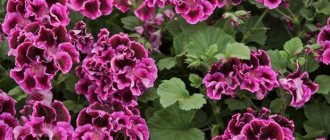Zonal pelargonium Joy (and there is also royal pelargonium with the same name) has every chance of becoming my favorite.
I received it as a terrible thing: the parcel with the cuttings took a very long time, and when I finally received it, the plants were in a deplorable state.
Chlorotic leaves, long internodes. This was aggravated by the fact that the former owner compacted the soil so much during rooting that a green coating appeared on the cups due to the fact that the soil was almost impervious to air. The roots of some cuttings ended up on the surface of the soil.
This is exactly how this future beauty Pelargonium Joy came to me. Now look what has grown out of it.
Pelargonium Edwards Pleasure
Plants with this shipping deadline are sent out from April 1 to May 30 in the order in which orders are received.
Plants with only one delivery date !
For all planting material
Dozens of payment methods
Fast and convenient delivery
Russian Post (Moscow and region within 24 hours), SDEK, Courier
Pelargonium Edwards Pleasure (Edwards Pleasure).
Dwarf zonal pelargonium. The bush is stocky and branches well. The inflorescences are double, large, warm salmon-colored with light tints.
Planting pelargonium: Even a novice gardener can plant pelargonium in the garden - the process does not require compliance with any complex rules. You just need to remember about the long roots of the plant when digging holes about 20 cm deep. When planting, it is better to leave a distance of 20-30 cm between the bushes.
Caring for pelargonium: Pelargonium requires systematic moderate watering: the soil should not be allowed to dry out or there should be a large amount of moisture in the soil. The flower does not need spraying. Garden varieties of pelargonium do well in partial shade; flowering is weak in direct sunlight. Therefore, on particularly hot days, darkening is required. The optimal air temperature for garden plants is no more than +20 °C.
Soil for planting: Pelargonium Edwards Pleasure (Edwards Pleasure) is quite demanding on the soil. The ideal solution is unused, loose soil with good drainage. For young plants without a formed root system, light soil is more suitable, so sand and peat, vermiculite and perlite are added to the composition. The soil for planting must be sufficiently fertile and well-drained. Pelargonium should not be planted in loamy and clayey soils.
Preparing for winter: Already in the fall, the pot with the plant is placed in a cool and dimly lit place. A southern or northern window sill in a house/apartment is quite suitable for this, since there is diffused sunlight there. And to make up for the lack of light at this time, you can use fluorescent lamps. The optimal daylight hours are 12 hours.
Planting location: The ideal location in the garden for Edwards Pleasure pelargonium will be in sunny areas. However, even in partial shade it is able to fully develop and bloom profusely throughout the season.
Reproduction of pelargonium by cuttings: You need to prepare a sharp knife or scalpel and disinfect it with alcohol. In no case should you use a blunt instrument, as this can damage the tissue of the cuttings and slow down the growth of future roots. Cuttings are cut from shoots directed at right angles to the main one, and at least 3 leaves should grow on them. For tall varieties of geranium, the length of the cuttings should be about 5-7 cm, for short and miniature varieties - 2.5-4 cm. The cut is made at right angles to the stem.
The Gardens of Eden online store will help make your dreams of creating the perfect garden come true. We will be useful for professional and novice gardeners, for collectors of rare varieties, for landscape designers, for communities of joint purchases. We work directly with the largest and most time-tested manufacturers of planting material, from all over Europe and Russia. And we offer for sale without intermediaries seedlings of ornamental perennial plants, shrubs, trees, conifers, as well as fruit and berry and bulbous plants. We also have our own production of perennial plants, which we grow for you with love and care. All plants are adapted to the Russian climate. Our assortment includes thousands of different varieties, as well as exclusives and new items. We carefully select only the best offers, eliminating unscrupulous manufacturers with possible mis-grading. Carefully designed packaging allows plants to be delivered in excellent condition even to the far corners of the country. We love our customers, therefore we take a very responsible approach to the issue of the quality of planting material, and are also responsible for the work of the Russian Post and transport companies.
Quality guarantee For the entire range
Geranium varieties
Description of pelargonium
There are more than 300 species of geranium in the world, and most of them grow wild in South Africa. However, some species grow on our windowsill, in boxes on the balcony, in the garden, the diversity of which we can admire all summer long.
Field geranium
What does geranium look like? They have fragile and long stems that become woody over time. With good care they bloom profusely. Their leaves are shiny and relatively durable.
Geranium has spread well in recent decades. The choice of color shades is no longer limited to pink, white or red. Now these are bright combinations. The leaves are also varied, with different shades.
Pink geranium flower
Multi-colored and fragrant geraniums will bring beauty and benefit to your home. The aromatic leaves contain essential oils and smell wonderful. Their aroma repels mosquitoes. Flavored leaves can be successfully used in cooking: added to jam or jelly, replacing lemon zest. Placed in cake dough, can be used to produce medicinal syrups.
Varieties
Balcony pelargoniums are available in many varieties derived from crossing species, including a very large number of cultivars. Geraniums can be divided into four main groups:
- zonal geraniums;
- scented geraniums;
- large-flowered;
- ivy-shaped.
The most famous are the Zonale hybrid, popularly known as simple geranium. The round stems are woody, in the form of a small bush 35 cm high. The leaves have a darker arched pattern. The flowers are large, simple or full: red, pink, purple or white. Blooms from April to October.
The second group are geraniums with aromatic foliage, the smell of which can be reminiscent of rose, pine, lemon or mint. Their popularity has increased in recent years.
Pelargonium lemon
Geranium, with its aromatic leaves, is little known and is commonly grown as a houseplant. However, they are often hardy enough to grow in the garden during summer days. The aromas of these geraniums differ depending on the type. Pelargonium graveolens has a pleasantly fresh lemon aroma. There are geraniums whose leaves smell like roses, have the scent of apple, mint, eucalyptus, or have a sweet-spicy scent.
Pelargonium fragrant Gourmet
Pelargonium fragrant odorata Orange
Lemon scented geraniums were developed in Europe in the late 18th century through natural crossing and then improved through selection. The aromatic plant has a very pronounced lemon aroma. Lemon geranium is grown in tropical areas to produce an essential oil used in perfumes, insect repellents, and the food industry.
Scented geranium is also a medicinal plant, known for its many properties: antibacterial, antifungal, astringent, hemostatic and tonic.
Large-flowered or English geraniums are among the most beautiful flowers. They are usually grown as houseplants and produce truly beautiful flowers from April to June. Flower petals are often two-colored or single-colored. Large-flowered geraniums are grown in white, pink, red, and purple colors. They bloom mainly in the spring months; flowers do not form during high summer temperatures. They need a sunny spot near a window, protected from strong afternoon sun.
Red rambler pelargonium
Geranium Ivy (Pelargonium peltatum)
The most famous and one of the most beautiful and very interesting species. Geraniums have leaves similar to ivy leaves. Flowers can be not only simple, but also full. A single flower resembles an azalea flower and can be up to five centimeters in diameter.
The stems of this species hang freely and decoratively fall to the edge of the pot. Over time, geranium creates a dense, highly branched shrub that can reach a height of up to 50 centimeters. This is one of the reasons why it is sometimes necessary, especially in spring, to prune it. The plant will create new shoots and return to its original size. The usual flowering time is from spring to autumn. The slender, free-hanging stems make them best suited for hanging in containers and flower boxes.
Additional Information! Indoor plants are placed on sunny windows. Only in very hot summers can they be placed outside in a protected place: these flowers do not tolerate dew and therefore rain.
The soft pink and white variety is suitable for hanging containers.
Silk Swan Pelargonium
Unusual species
New varieties appear every year: rich flowering, weather-resistant, with large flowering inflorescences.
- Ringed geranium. A characteristic feature of this species is the circular pattern on the leaves. The flowers are red, crimson, scarlet and rarely white.
- Cascading pelargonium is characterized by very rich flowering, creating overhanging cascades of flowers.
- Dwarf varieties. In floriculture, mini-flowers have appeared, only 20 cm high and blooming with smaller flowers. They especially stand out when combined with dark purple centers and soft purple edges.
- Pelargonium Gravelens scented, lemon rose scented foliage.
- An antique pink zonal hybrid produces very wide umbrellas of flowers. Their very bright pink color is softened by a hint of white.
- Citronella. If you crush its leaves, they will release a citrus aroma.
- Pelargonium Lara Harmony is double, with bright pink flowers that look like roses. The bush is compact and fluffy.
Geranium Lara accordion
Note! Pelargonium Lara Harmony is amazingly beautiful!
Yellow pelargonium is a very rare flower.
Geraniums can be combined in the same pot with other flowering plants, herbs or plants with decorative leaves. Yellow, purple and red flowers in one pot look really good.
Pelargonium yellow first Yellow
Features of care
Hanging geranium varieties should be planted in taller containers or boxes to allow them to develop according to their growth habit.
- If the edges of the leaves turn yellow, more watering is needed.
- If the plant has enough moisture and fertilizer, and the leaves fall off, it should be moved to a brighter place.
- Watering fertilizers once a week is very important, you can also use slow release fertilizers in the soil.
- Moderate watering without wetting the flowers.
- Replanting is necessary for lush growth and an abundance of flowers.
Note! Easy to grow and bloom, geraniums require fertilization and regular removal of spent flowers to ensure continued blooms.
All groups at home are equally propagated by cuttings. The best period for this work is the end of summer, as there is still good lighting and warmth. Young shoots from mother plants can be used as cuttings. Using scissors or a knife, cut the stem so that at least three eyes remain on it, from which new shoots will appear in a short time. A light substrate with a predominant proportion of peat is suitable for geraniums, since their roots completely fill the pot.
Blooming house
Good day to everyone who has visited the pages of my site.
in pelargoniums 2016 I want to show both the oldies of my collection and the new varieties.
Edwards Elegans. Large, white-pink flower caps with jagged edges of the petals. Delicate but expressive flowering of this variety. The bush does not cause problems, it forms well. This variety is part of my main collection. Not all varieties of the Edwards series performed well in my conditions content, but this particular variety has a permanent residence permit.
Ludwigsburger Flair.. my good old variety, which still appeals to me now. One of the first to appear on my windowsill, lives to this day. Was, is and will always be! I love its gentle tints in the caps, the greenness of the leaves and the tractability of the content.
new Greenacres , an upstart with long peduncles, the bush needs to be formed immediately, the variety is recognizable both by the bush and the flowers - this is a big plus. The flowers are porcelain-white, the petals are dense, wavy, the first caps are very large, lacy. There is also a minus. The variety still tries after pinching drive the top into two, three branches at best.
Calypso's favorite , this spring almost all the cuttings taken from the plant in February took root; last year there was only one rooted cutting from this variety over the summer. As soon as the variety started flowering, and it blooms profusely and for quite a long time, cuttings from it practically do not take root .
Lara Harmony is a wonderful variety that can bloom well both on the window and on the street. The photo shows a heavily pruned mother plant in a pot growing on the street. It quickly grew...blooms.
new varieties this year
BROOKSIDE KATERINA . Beauty, beauty and beauty again! Bright, bold in color, with a white backlight radiating across the petals from the center of the flower... you can notice this immediately, expressive and spectacular pelargonium... I really liked it. Large flower, neat cap. Grows slowly, forming a fluffy bush.
Gerda , very helpful in the bush, strong, stocky, well formed. The caps are large, full-bodied, voluminous.
another new one. Odensjo Madame Bovary
As soon as she showed the first flower... that's it! it was love, right away... this variety is very difficult to photograph. Delightful, deep and velvety red and dark foliage. The variety is very beautiful and contrasting! The inflorescence is not large, but this is for now, the plant is still young.
Anita , blooms from cuttings, sets flower stalks well, very delicate in color, fluffy inflorescences...balls of roses!
Prince Gustav...a prince he is a prince!
I probably took the shape of a leaf from the mother tulip, also slightly curled and harsh to the touch, medium in size, shiny. Not lazy, it lays flower stalks actively, even very actively. It took me a long time for an autumn cutting to take root, it survived the winter normally, but in the spring, in the best place on the windowsill, it dropped a fair amount of foliage, then after transplanting it into a spacious pot, it began to grow a bush. He liked it most on the balcony, having received an abundance of light and air... the bush was transformed! Variety definitely interesting and deserves attention. The buds look like ice cream balls, they take shape slowly, the inflorescence stays fresh for a long time.
PAC Viva Madeleine, this year, the February cuttings are blooming.
Misty…
Misty...very spectacular flowering, the white underside on a soft orange inflorescence captivates anyone...but it can be pretty stubborn, maybe it depends on the season or on the cutting...I don’t know for sure. Sometimes it blooms from a cutting, and sometimes it will form a good bush, but it will flourish mediocre. In This year the bush is good and there were two waves of flowering, but it began to expose the bottom of the bush. This variety needs a greenhouse, there it can be a real beauty! I will never give up this variety, it is too extraordinary and there are few like it.
Bold Diamond Wedding
, a wonderful representative of the Bold series
,
blooms more than it grows, the bush is still medium in size, but fluffy.
Marshmallow-pink inflorescences, delicate flower petals in a cap, you need to choose a place so that they do not get baked in the sun. I really respect the Bold series ,
after trying many varieties of the Odensjo and Edwards series, it is its varieties that I have most collected and remain in the collection, I am waiting for more individual varieties to come to me.
Rules for caring for pelargonium seedlings at home
Under normal conditions, scarified seeds will germinate in 1-1.5 weeks after sowing, and regular seeds without treatment - in about 2-3 weeks. But the conditions should be as follows:
- Seeds need greenhouse conditions to germinate, i.e. high humidity and heat. Therefore, from the moment of planting until germination, the container must be covered with something (glass, film, lid).
- The container with soil and seeds should be kept in a room with a temperature of about 24-27 degrees Celsius.
- It is advisable to ventilate the container daily to avoid excessive moisture and mold. You literally need to remove the lid and film for 20-30 minutes.
- It is important to monitor soil moisture. As a rule, the soil does not have time to dry out before the first shoots, but if it starts to dry out, you will need to carefully moisten it with a spray bottle.
- When you see pelargonium shoots, you will need to remove the covering material forever. But it is advisable to do this gradually, over several days.
After the emergence of seedlings, the main task of the gardener is to concentrate on caring for pelargonium seedlings at home:
- Transfer the young plants to the sunniest windowsill or under phytolamps (if it is possible to turn them on for 12 hours a day). If even on the windowsill the seedlings do not have enough natural light, then they need to be additionally illuminated with phytolamps (this is especially true in winter and early spring). With a lack of light, geranium seedlings will begin to stretch.
- It is also necessary to change the temperature regime. Now the optimal temperature for seedlings is: +18-20°C during the day, +16-18°C at night.
- It is recommended to periodically (once every few days) turn the container with plants to the sunny side. This manipulation will avoid distortion of the seedlings, because they will be illuminated evenly.
- You need to be especially careful when watering geranium seedlings. Water the plants only when the top layer of soil dries out, not earlier. Excess moisture can cause fungal diseases, mold, and root rot. Lack of moisture is also dangerous, so the earthen ball should never dry out. The quality of the water is also important: it must be soft, clean, settled, and at room temperature.
- If you planted several seeds in one glass or pot, then you should leave only 1 strongest and strongest sprout.
Peculiarities
Pelargonium belongs to the Geraniaceae family. South America is considered the birthplace of the plant. Some varieties also grow on the African continent, Australia and other tropical areas. Pelargonium flowers are large, with elongated sepals, in appearance they slightly resemble the beak of a crane or stork, for which the plant received its name Pelargonium, translated from Greek meaning “crane nose”.
The color of the flowers has a wide range and, depending on the variety, can vary from light, almost white, to dark purple, almost black.
It is believed that pelargonium was first introduced into Europe in 1672. Botanist-collector Paul Hermann sent several specimens of this plant from South Africa.
Amateur flower growers greatly value pelargonium for its luxurious appearance and long flowering period. In addition, this plant is not capricious and does not require any special care. However, pelargonium is valued not only for its visual attractiveness. It has a lot of useful properties. So, an infusion from the leaves of this plant normalizes blood pressure and calms. A compress of flowers heals open wounds and speeds up the healing process.
As mentioned above, pelargonium belongs to the Geraniaceae family, so the two cultures are often confused with each other. Meanwhile, there are differences both in the shape of the flower and in the size of the plant itself. In 1738, the Dutch scientist Johannes Burman first separated these two names, however, another scientist, botanist Carl Linnaeus from Sweden, challenged this statement in 1753 in his scientific work “Varieties of Plants” and combined the two flowers into one group.
Disputes about this continue to this day. Meanwhile, those flowers that grow everywhere in almost every home are pelargoniums. Unlike geranium, which feels great even at sub-zero temperatures, pelargonium is very thermophilic and does not overwinter in open ground.
Pelargonium petals are of different sizes - the lower ones are smaller, and the closer to the top of the flower, the longer they are. In addition, despite all the variety of colors, pelargonium does not have blue flowers.
Pelargonium Joy - the most beautiful of the beautiful
I rarely see this variety in gardeners’ collections, so I was wondering whether to order it or not. Maybe he's capricious? Maybe it grows into a huge stick and rarely blooms? But I liked these flowers in the photo so much that I decided to take a risk. And this is what I can tell you about him.
Pelargonium Joy quickly adapted after the hellish trip in the postal parcel. She responded very gratefully to the feeding and quickly began to grow. I grew a small bush and threw away the flower stalk. I waited a long time for Pelargonium Joy to show its flowers, but it only lengthened and lengthened its peduncle. As a result, the photo clearly shows that the bush is small and strong, and the peduncle is very long!
And what a hat of flowers he’s wearing! It was huge, so heavy that I had to prop the pot up with something so that it wouldn’t tip over under the weight of the flower. Large, dense flowers are collected in a tight cap. And what petals! A combination of white with delicate salmon stains. In short, Pelargonium Joy is a stunning beauty!
I didn’t notice any whims about her. A very grateful plant and simply kills on the spot with the beauty and size of its inflorescences. The leaves do not stand out in anything special: green, with a lighter zone in the center of the leaf and darker towards the edges.
If you, like me, spent a long time scouring the Internet and decided not to buy this plant just because there is almost no information about it, you are probably biting your elbows right now.
